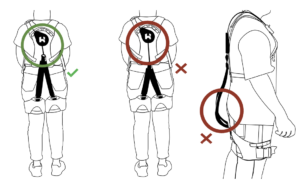Adjustment tips to get a comfortable fit and the maximum support from the Apex 2 exosuit
Good fit is critical:
- Device should be snug
- There should be no discomfort
- When device is ON, should feel the support and assistance
- If something feels off or discomfort, most likely an adjustment needs to be made
- Take time with adjustments
- Over time, device may settle to your body and straps may loosen inadvertently or suit may be looser or tighter with different clothing
- Subtle changes can make a big difference
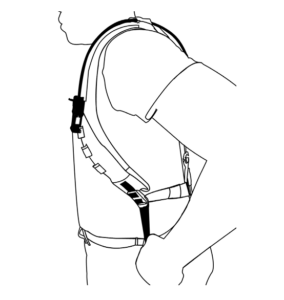
Shoulder Straps and Chest Strap:
-
- Should be snug, but comfortable. User should be able to take a deep breath easily, reach forward without irritation, and move freely while not feeling constricted in any way
- Tighten the shoulder strap by pulling down and back on the webbing. (see image)
- Loosen shoulder straps by lifting up on the ladder locks at the bottom of each shoulder strap and pulling forward
- The switch on the left shoulder strap should sit at collarbone level or lower. If the switch is placed higher on the shoulder, pull down on both shoulder straps and tighten.
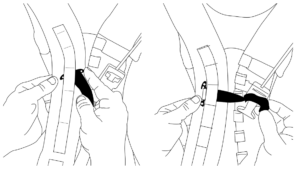
- The chest strap can be adjusted higher or lower by removing MOLLE-T from loop on right shoulder strap and moving to desired level. You can also add a secondary chest strap to alleviate shoulder strap discomfort. Adding or moving the chest strap can pull the shoulder straps toward the inner part of the user’s shoulder, creating a vest-style fit. Ensure the MOLLE-T end is fully inserted into the shoulder strap loop and positioned vertically. (see image)
- Place extra material in webbing keepers
Thigh Sleeve Anchors:
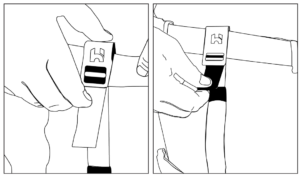
- Attach at least one thigh sleeve anchor to each thigh sleeve. A second thigh sleeve anchor can optionally be attached to each thigh sleeve for additional support. Ensure that the anchor is aligned with the outside seam of your pants, then hook the thigh sleeve anchor over your belt near your hip bone and tighten until there is no slack. Repeat for both legs.
- Make sure “H” logo is facing away from body when attaching to belt
- Adjust so there is no slack in rope attached from thigh sleeves to belt
- Place excess material in webbing keepers
Thigh Sleeves:
-
 Thigh sleeves should be snug but not uncomfortable or cutting off circulation. To tighten thigh sleeves, hold the buckle and pull the webbing in towards the inner thigh.
Thigh sleeves should be snug but not uncomfortable or cutting off circulation. To tighten thigh sleeves, hold the buckle and pull the webbing in towards the inner thigh. - Once tightened ensure your bands are aligned along the center of the buttock and the buckle is aligned with the outside seam of your pants. To loosen thigh sleeves, lift at the bottom of the female-side of the buckle. Some users find it easier to unbuckle the thigh sleeve to adjust tightness before refastening the buckle.
- Each thigh sleeve is labeled “Left” or “Right”
- Buckles too far forward on thigh will not provide as much assistance
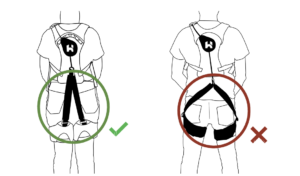
- Buckles too far on back of leg will cause discomfort with bands between buttocks
Checking Band Length:
- Loose bands will not provide appropriate support or assistance
- Too short of bands will expose great amounts of rope from clutch in a standing position
- Ideally, want 1-3 inches of rope exposure from clutch on back panel
- If the bands are too long, may need to tighten the shoulder straps
- “Sweet spot” band length will not have any tension nor too much slack when standing upright
- After adjustments are made and there is still too much slack or tension, may need to exchange bands out for different length

- There should be no slack in the user is standing upright. Shorter bands should be used if there is less than one (1) inch (3 cm) of rope extended from the clutch when the user is standing upright . Longer bands should be used if over four (4) inches (10cm) of rope is exposed when the user is standing upright
Band Strength:
- Correct strength will allow you to bend or squat without fighting against Apex 2
- There are 3 band strengths: 1,000, strong (1500), or extra-strong (2000)
- If using extra-strong and you feel like you are fighting against the suit to bend or lift, probably should switch to strong bands
- If using strong bands and feel like you need more assistance, switch out to extra-strong strength
- Strong (1500) bands are a good place to start and then adjust accordingly depending on job task and how you feel
Was this article helpful?
Thank you for your feedback.
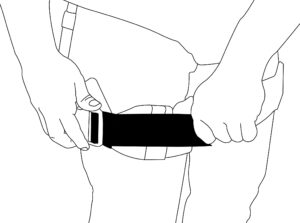 Thigh sleeves should be snug but not uncomfortable or cutting off circulation. To tighten thigh sleeves, hold the buckle and pull the webbing in towards the inner thigh.
Thigh sleeves should be snug but not uncomfortable or cutting off circulation. To tighten thigh sleeves, hold the buckle and pull the webbing in towards the inner thigh. 